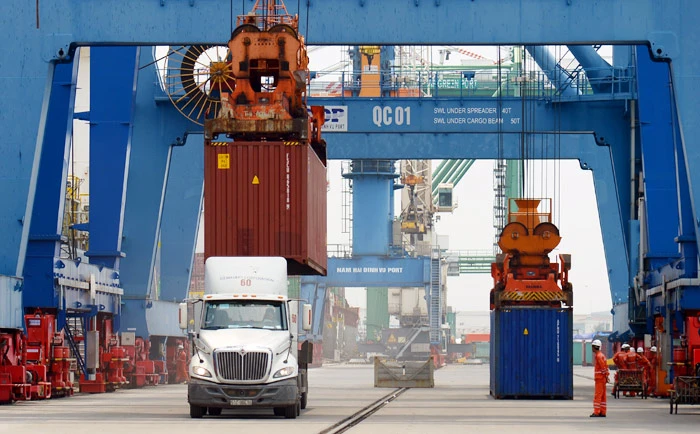
This particular FTA is expected to play an important role in trade and investment with participating countries that currently account for 30% of the world population as well as 30% of global GDP.
Economic impact
As of 7 December, eleven countries have ratified the RCEP agreement, which include six ASEAN countries, namely, Singapore, Laos, Cambodia, Brunei, Vietnam, and Thailand, and five non-ASEAN countries, namely, China, Japan, New Zealand, Australia, and South Korea. When RCEP finally comes into effect, ASEAN countries are expected to create a strong momentum for recovery in three major aspects.
Firstly, there will be reduced tariffs and unified rules of origin. Before RCEP, exports from ASEAN countries were usually carried out within the framework of ASEAN+1 FTAs, such as ASEAN-China (ACFTA), and ASEAN-Japan (AJCEP). In intra-regional trade, the ASEAN Trade in Goods Agreement (ATIGA) was used. These agreements provided different rules of origin. For instance, for ACFTA, businesses used form E, for ATIGA it was form D, and for AJCEP it was form AJ.
When the rules of origin are agreed upon, it will create better conditions for goods to circulate, help businesses increase their ability to meet the conditions for preferential tariffs, and increase exports in the region. In addition, RCEP will eliminate upto 90% of tariffs on goods exchanged between signatories in the next twenty years from the date it is enforced. In 2022, China will eliminate upto 70% of tariffs on goods imported from ASEAN, which will be a huge benefit as China is one of the three largest export markets of ASEAN. Other ASEAN countries such as Singapore, Brunei, Thailand, and Vietnam will also eliminate upto 75% of tariffs on imports from China.
Secondly, RCEP will strengthen harmonization of non-tariff measures (NTMs). NTM food safety standards, packaging, and labeling requirements will be promoted for transparency through the application of international standards and mutual recognition of assessment procedures between participating members. Despite some progress in NTM related regulations in ATIGA, businesses still frequently complain about the complexity and cost of complying with non-tariff standards imposed by import partners.
Thirdly, RCEP is expected to stimulate cross-border e-commerce. RCEP will promote paperless commerce, carry out administrative procedures by electronic means, and recognize legality on par with paper records. It will also encourage authentication and electronic signatures. Besides, RCEP also has provisions to protect network users and personal data.
Conditions for Vietnam
In the trade structure, RCEP accounts for 50% to 55% of Vietnam's total import and export turnover. In this, exports account for about 25% to 30%, and imports account for 70%. Hence the first challenge is to reduce the trade deficit from RCEP countries. By taking advantage of favorable conditions to exploit markets that are still sluggish after the pandemic, we are likely to experience an expansion of the trade deficit. In this context there are many enterprises having abundant resources, especially in China and South Korea, the two largest trade deficit countries of Vietnam. If there is no handling of these measures, it will affect the exchange rate and thereby greatly affect the revenue of Vietnamese exporters.
In addition to the import problem, Vietnamese enterprises must compete with partners in accessing attractive markets. Previously, because of bilateral and ASEAN+1 FTAs with Japan and South Korea, Vietnam partly had a tariff advantage over rivals such as China. However, with disadvantage of capital as well as low management capacity and technology level, we may gradually lose market share to other enterprises. In order to overcome these inadequacies, Vietnamese enterprises need to actively prepare and learn the habits and tastes of these vital export markets.
Vietnam is considered to have many advantages in export of agricultural and aquatic products, which meets the needs of many countries. However, the ability to add value to exports is not high because agro-forestry-fishery enterprises often use Free On Board (FOB) prices, that are released from liability when goods are delivered at the port of departure. Ever since the Covid-19 pandemic appeared, most partners requested to switch to Cost, Insurance and Freight (CIF), which is the price at the border gate of import party, including cost of insurance and transportation of goods to border gate of the import party. This has made many businesses passive because they have no experience in negotiating with shipping lines.
Another problem is in promoting e-commerce to catch up with the trend. Besides some outstanding achievements due to the online shopping boom during the lockdown period, Vietnamese e-commerce still show many weaknesses such as higher prices and poor quality as compared to advertising images, as well as risk of disclosure of personal information. In the context that RCEP requires parties to improve their ability to protect consumer personal information online, this weak point can make Vietnamese enterprises much inferior to foreign competitors.
To overcome this situation, state agencies should consider promoting the provision of public services such as electronic customs, tax declaration and payment, and electronic import and export procedures. At the same time, support enterprises need to distribute and circulate goods at home and abroad, complete information, transport and logistics infrastructure, to reduce the burden of costs, and facilitate product cost reduction. There should be a clear legal framework to ensure the safety of e-commerce platforms as well as consumer information.




















